Resident Crews of the International Space Station (ISS)
![]()
ISS: Expedition 39 |
 |
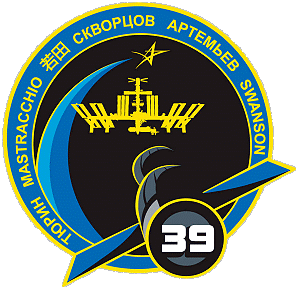 |
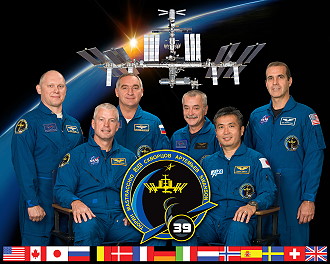 |
alternative crew photo |
|
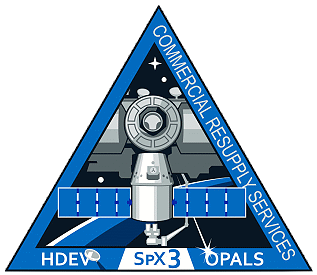 |
![]()
Crew, launch- and landing data
| No. | Nation | Surname | Given names | Position | Spacecraft (launch) |
Launch date |
Launch time |
Spacecraft (landing) |
Landing date |
Landing time |
Mission duration |
Orbits |
| 1 | Wakata | Koichi | ISS-CDR | Soyuz TMA-11M | 07.11.2013 | 04:14:15.290 UTC | Soyuz TMA-11M | 14.05.2014 | 01:58:06.8 UTC | 187d 21h 43m 52s | 2916 | |
| 2 | Skvortsov | Aleksandr Aleksandrovich Jr. | Flight Engineer-1 | Soyuz TMA-12M | 25.03.2014 | 21:17:23.053 UTC | Soyuz TMA-12M | 11.09.2014 | 02:23:09.0 UTC | 169d 05h 05m 46s | 2626 | |
| 3 | Artemyev | Oleg Germanovich | Flight Engineer-2 | Soyuz TMA-12M | 25.03.2014 | 21:17:23.053 UTC | Soyuz TMA-12M | 11.09.2014 | 02:23:09.0 UTC | 169d 05h 05m 46s | 2626 | |
| 4 | Swanson | Steven Ray "Swanny" | Flight Engineer-3 | Soyuz TMA-12M | 25.03.2014 | 21:17:23.053 UTC | Soyuz TMA-12M | 11.09.2014 | 02:23:09.0 UTC | 169d 05h 05m 46s | 2626 | |
| 5 | Tyurin | Mikhail Vladislavovich | Flight Engineer-4 | Soyuz TMA-11M | 07.11.2013 | 04:14:15.290 UTC | Soyuz TMA-11M | 14.05.2014 | 01:58:06.8 UTC | 187d 21h 43m 52s | 2916 | |
| 6 | Mastracchio | Richard Alan "Rick" | Flight Engineer-5 | Soyuz TMA-11M | 07.11.2013 | 04:14:15.290 UTC | Soyuz TMA-11M | 14.05.2014 | 01:58:06.8 UTC | 187d 21h 43m 52s | 2916 |
unofficial Backup Crew
| No. | Nation | Surname | Given names | Position |
| 1 | Gerst | Alexander | ISS-CDR | |
| 2 | Samokutyayev | Aleksandr Mikhailovich | Flight Engineer | |
| 3 | Serova | Yelena Olegovna | Flight Engineer | |
| 4 | Wilmore | Barry Eugene "Butch" | Flight Engineer | |
| 5 | Surayev | Maksim Viktorovich | Flight Engineer | |
| 6 | Wiseman | Gregory Reid | Flight Engineer |
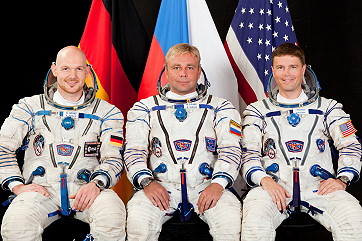 |
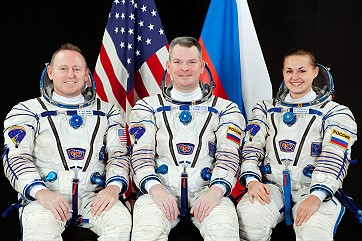 |
 |
Expedition Report
|
Launch from the Baikonur Cosmodrome (Aleksandr
Skvortsov, Oleg
Artemyev and Steven
Swanson with
Soyuz
TMA-12M). Mikhail
Tyurin, Richard
Mastracchio and Koichi
Wakata were onboard since November 07, 2013 (arrival with
Soyuz
TMA-11M). ISS Expedition 39 began with the undocking of spacecraft Soyuz TMA-10M on March 11, 2014 at 00:02:32 UTC. The former Expedition 38 (Oleg Kotov, Sergei Ryazansky and Michael Hopkins) returned safely to Earth. With the arrival of Soyuz TMA-12M on March 27, 2014 the Expedition 39 became a six-person-crew. Soyuz TMA-12M carried Aleksandr Skvortsov, Oleg Artemyev and Steven Swanson to the space station. Soyuz TMA-12M, kicking off a planned four-orbit, six-hour rendezvous with the station. They executed the first two rendezvous firings on schedule, but the third firing was not carried out, possibly because the spacecraft was not in the expected attitude, or orientation. With the rendezvous sequence interrupted, Russian flight controllers defaulted to the more traditional two-day sequence. Progress M-22M undocked from the ISS on April 07, 2014 at 13:58 UTC. Progress remained in orbit for the non-ISS-related "Radar-Progress" experiment. The freighter was de-orbited on April 18, 2014 over the South Pacific. Progress M-23M was launched on April 09, 2014 at 15:26:27 UTC from the Baikonur Cosmodrome in Kazakhstan. The unmanned freighter docked with the Pirs docking compartment on April 09, 2014 at 21:14:18 UTC, less than six hours after launch. The Progress spacecraft carried 2686 kg of cargo, including 1,764 pounds (800 kg) of propellant to be pumped inside the Russian Zvezda service module, 105 pounds (48 kg) of oxygen and air to replenish the atmosphere inside the space station, 926 pounds (420 kg) of water, and 3,126 pounds (1,418 kg) of supplies and experiment hardware, including fresh food, medical supplies, electronic equipment and other gear to the International Space Station. A Dragon cargo craft (CRS-3 or SpX-3) stuffed with science and supplies approached the International Space Station for an automated laser-guided final rendezvous April 20, 2014, culminating with grapple by the outpost's robotic arm. Owned by SpaceX, the Dragon spacecraft completed a 40-hour trip from launch to the international research complex at 11:14 UTC, when space station commander Koichi Wakata guided the lab's robot arm to grapple the free-flying cargo capsule. Dragon was berthed to the Harmony module at 14:06 UTC. SpaceX delivered 4,600 pounds (2,087 kg) of supplies, logistics and experiments aboard the Dragon spacecraft. The space station's astronauts will manually unpack the 3,347 pounds (1,518 kg) of gear stowed in Dragon's internal module, while the outpost's Canadian-built robotics systems will remove two payloads mounted inside Dragon's trunk. The Dragon spacecraft blasted off April 18, 2014 at 19:25:22 UTC on top of a Falcon 9 rocket from Cape Canaveral Air Force Station, Florida. The Dragon supply ship reached the space station after a series of engine burns to fine-tune its course toward the 450-ton orbiting complex. The Progress M-21M resupply craft separated from the International Space Station at 08:58:20 UTC on April 23, 2014 and completed its first engine fire to move it a safe distance away. Progress M-21M rendezvoused with a new system, known as Kurs-NA. Kurs-NA uses only a single antenna, allowing four others to be removed, leaving only three or half as many as current versions of the spacecraft. Kurs-NA also will use less power, improve safety and possess updated electronics. The re-docking occurred on April 25, 2014 at 12:13:11 UTC with the Zvezda module. Two previous tests of the Kurs-NA systems had failed in July 2012 and November 2013. On April 23, 2014 an EVA by Richard Mastracchio and Steven Swanson (1h 36m) was needed. The astronauts replaced a backup multiplexer-demultiplexer (MDM) that failed during routine testing April 11, 2014. The box is one of the station's two external MDMs that provide commands to some of the space station's systems, including the external cooling system, solar alpha rotary joints (SARJ) and mobile transporter rail car. The multiplexer-demultiplexer (MDM) is 27 x 42 centimeters in diameter and has a mass of 23 kilograms. High definition camera equipment, growing plants in space, and a variety of physical science, biology and biotechnology experiments define the research of Expedition 39. Other investigations include human research, technology demonstrations and educational activities. Expedition 39 activities will continue to advance our body of scientific knowledge, provide a platform for Earth and astronomical observation, educate and inspire younger generations and prepare future crews for deep space exploration beyond low-Earth orbit. Vegetable Production System (Veggie): Veggie is a plant growth facility capable of producing salad-type crops to provide the crew with appetizing, nutritious and safe fresh food and supporting crew relaxation and recreation. The Veggie unit provides lighting and nutrient delivery, but uses the cabin environment on the space station for temperature control and as a source of carbon dioxide to promote growth. This study will emphasize the focus on human habitability in space, since growing food in microgravity may improve long-duration spaceflight. Veggie can support a variety of studies used to determine how plants sense and respond to gravity. Astronauts will harvest the plants for further investigation. With continued plant growth studies aboard the space station using facilities like Veggie, crews may one day consume produce during long-term missions in low-Earth orbit or to an asteroid or Mars. The Veggie unit's growth volume will be the largest volume available to date for plant growth on the space station, which will enable larger produce than was previously available, due to size restrictions. This improved understanding of plant growth and development in microgravity has important implications for improving plant growth and biomass production on Earth. Advanced Colloids Experiment-Microscopy-2 (ACE-M-2): ACE-M-2 examines the behavior of liquids and gases near the critical point, or the point at which there is no distinct boundary between the liquid and gas phases. ACE-M-2 uses a new microscope to record micro-scale events on short time scales; previous experiments observed large-scale behavior over many weeks. Liquids and gases of the same material usually have different densities, so they would behave differently under the influence of gravity, making the microgravity environment of the International Space Station ideal for these experiments. Particle separation and behavior in liquids, gels and creams is important for developing consumer and household products on Earth. The ACE investigations on the space station provide insight into product formulations that could be used to maximize stability and shelf life. High Definition Earth Viewing (HDEV): The HDEV investigation places four commercially available high definition cameras on the exterior of the space station for use in streaming live video of Earth for online viewing. The cameras are enclosed in a temperature-specific case and exposed to the harsh radiation of the space environ-ment. Analysis of the effect of space on the video quality during the HDEV operational period may help engineers determine the best types of commercially available cameras to use on future missions. Using available products may be more cost-effective than designing new products. High school students helped design some of the cameras' components, through the High Schools United with NASA to Create Hardware program, and student teams will operate the experiment. Image can be seen in a live stream at http://eol.jsc.nasa.gov/HDEV. MicroRNA Expression Profiles in Cultured Human Fibroblasts in Space (Micro-7): The majority of cells in the human body are non-dividing cells that provide critical functions, from blood cells to cells in different organs. Micro-7 studies how microgravity affects the genetic expression and physical shape of these types of cells for the first time. Understanding how these cells function in microgravity is a step toward understanding how organs, tissues and the entire body change during spaceflight. Researchers can use data from Micro-7 in future Earth-based studies to examine whether the cell changes observed during spaceflight are seen in disease states of tissues and organs as well. Ultimately, this may help scientists better understand disease. This type of research could lead to developing new drug treatments. Finally, the station command changed from Japanese astronaut Koichi Wakata to US astronaut Steven Swanson. With undocking of Soyuz TMA-11M on May 13, 2014 at 22:35:56 UTC, carrying Mikhail Tyurin, Richard Mastracchio and Koichi Wakata the Expedition 39 concluded and the new ISS Expedition 40 began. During the stay on board of the ISS the crews of Expeditions 39 / 40 carried out the following scientific experiments: 3D Printing In Zero-G (3D Printing In Zero-G Technology Demonstration) 3DA1 Camcorder (Panasonic 3D Camera) ACE-M-2 (Advanced Colloids Experiment-Microscopy-2 ) ACE-M-3 (Advanced Colloids Experiment-Microscopy-3) AES-1 (Antibiotic Effectiveness in Space-1) AMO-TOCA (Autonomous Mission Operations TOCA Autonomous Operations Project) AMS-02 (Alpha Magnetic Spectrometer - 02) APEX-02-2 (Advanced Plant EXperiments-02-2) ATOMIZATION (Detailed validation of the new atomization concept derived from drop tower experiments--Aimed at developing a turbulent atomization simulator) Alloy Semiconductor (Crystal Growth of Alloy Semiconductor Under Microgravity) Amine Swingbed (Amine Swingbed) Aniso Tubule (Roles of cortical microtubules and microtubule-associated proteins in gravity-induced growth modification of plant stems) Area PADLES (Area Passive Dosimeter for Life-Science Experiments in Space ) BASS-II (Burning and Suppression of Solids - II) BCAT-3-4-CP (Binary Colloidal Alloy Test - 3 and 4: Critical Point) BCAT-4-Poly (Binodal Colloidal Aggregation Test - 4: Polydispersion) BCAT-C1 (Binary Colloidal Alloy Test - C1) BCAT-KP (Binary Colloidal Alloy Test - Kinetics Platform) BP Reg (A Simple In-flight Method to Test the Risk of Fainting on Return to Earth After Long-Duration Space Flights) BRIC-18-1 (Development of Multiple Antibiotic Resistance By Opportunistic Bacterial Pathogens During Human Space Flight) BRIC-18-2 (Mechanisms for plant adaptation to space environment) Biochem Profile (Biochemical Profile) Biological Rhythms 48hrs (The effect of long-term microgravity exposure on cardiac autonomic function by analyzing 48-hours electrocardiogram) Biotube-MICRO (Biotube-Magnetophoretically Induced Curvature in Roots) Bisphosphonates (Bisphosphonates as a Countermeasure to Space Flight Induced Bone Loss) Body Measures (Quantification of In-Flight Physical Changes - Anthropometry and Neutral Body Posture) CARTILAGE (CARTILAGE) CASIS PCG HDPCG-1 (Crystallization of Huntingtin Exon 1 Using Microgravity) CASIS PCG HDPCG-2 (Advancing Membrane Protein Crystallization By Using Microgravity) CATS (Cloud-Aerosol Transport System) CCF (Capillary Channel Flow) CEO (Crew Earth Observations) CFE-2 (Capillary Flow Experiment - 2) CPCG-HM (Commercial Protein Crystal Growth - High density protein crystal growth Modified) CSI-06 (Commercial Generic Bioprocessing Apparatus Science Insert - 06: Ants in Space) Cardio Ox (Defining the Relation Between Biomarkers of Oxidative and Inflammatory Stress and Atherosclerosis Risk in Astronauts During and After Long-duration Spaceflight) Cell Mechanosensing-1 (Cell Mechanosensing-1) Cell Mechanosensing-2 (Cell Mechanosensing-2) Characterizing Arabidopsis Root Attractions (CARA) (Molecular Biology of Plant Development in the Space Flight Environment) Circadian Rhythms (Circadian Rhythms) Comm Delay Assessment (Assessing the Impact of Communication Delay on Behavioral Health and Performance: An Examination of Autonomous Operations Utilizing the International Space Station) CsPINs (Dynamism of Auxin Efflux Facilitators, CsPINs, Responsible for Gravity-regulated Growth and Development in Cucumber) DECLIC DSI-R (DEvice for the study of Critical LIquids and Crystallization - Directional Solidification Insert-Reflight) DOD SPHERES-RINGS (Department of Defense Synchronized Position, Hold, Engage, Reorient, Experimental Satellites-RINGS) DOSIS-3D (Dose Distribution Inside the International Space Station - 3D) DTN (Disruption Tolerant Networking for Space Operations) Dynamic Surf (Experimental Assessment of Dynamic Surface Deformation Effects in Transition to Oscillatory Thermo capillary Flow in Liquid Bridge of High Prandtl Number Fluid) EPO-Demos (Education Payload Operation-Demonstrations) Energy (Astronaut's Energy Requirements for Long-Term Space Flight) FASTER (Facility for Absorption and Surface Tension) FLEX-2 (Flame Extinguishment Experiment - 2) Force Shoes (In-flight Demonstration of Portable Load Monitoring Devices-Phase I: XSENS ForceShoe™) Functional Task Test (Physiological Factors Contributing to Postflight Changes in Functional Performance) Gravi-2 (Threshold Acceleration for Gravisensing - 2) HDEV (High Definition Earth Viewing) HREP-HICO (HICO and RAIDS Experiment Payload - Hyperspectral Imager for the Coastal Ocean) HREP-RAIDS (HICO and RAIDS Experiment Payload - Remote Atmospheric and Ionospheric Detection System (RAIDS)) HiMassSEE (Spacecraft Single Event Environments at High Shielding Mass) Hicari (Growth of Homogeneous SiGe Crystals in Microgravity by the TLZ Method) Hybrid Training (Effect of the Hybrid Training Method on the Disuse Atrophy of the Musculoskeletal System of the Astronauts Staying in the International Space Station for a Long Term-initial verification in ISS) ISERV (ISS SERVIR Environmental Research and Visualization System) ISS Ham Radio (International Space Station Ham Radio) ISS-RapidScat (ISS-RapidScat) ISTAR Comm Delay Prep (ISS Testbed for Analog Research Communication Delay Preparation) IVA Clothing Study (Intravehicular Activity Clothing Study) Ice Crystal 2 (Crystal growth mechanisms associated with the macromolecules adsorbed at a growing interface - Microgravity effect for self-oscillatory growth - 2) Intervertebral Disc Damage (Risk of Intervertebral Disc Damage after Prolonged Space Flight) JAXA EPO 12 (JAXA Education Payload Observation 12) JAXA PCG (Japan Aerospace Exploration Agency Protein Crystal Growth) JAXA-Commercial (Japan Aerospace Exploration Agency - Commercial Payload Program) Journals (Behavioral Issues Associated with isolation and Confinement: Review and Analysis of Astronaut Journals) MAXI (Monitor of All-sky X-ray Image) MCE (Multi-mission Consolidated Equipment) MDS (Mice Drawer System) METERON (METERON Quick Start a / DTN) MISSE-8 FSE (MISSE-8 FSE) MVIS Controller-1 (MVIS Controller 1) Manual Control (Assessment of Operator Proficiency Following Long-Duration Space Flight) Micro-7 (MicroRNA Expression Profiles in Cultured Human Fibroblasts in Space) Microbiome (Study of the Impact of Long-Term Space Travel on the Astronauts' Microbiome) Microgravity Growth of Antibody Crystals in the Hand Held High Density Protein Crystal Growth (Microgravity Growth of Single Antibody Crystals for Structure) Multi-Gas Monitor (Multi-Gas Monitor) NanoRacks-Heart Flies (Heart Effect Analysis Research Team conducting FLy Investigations and Experiments in Spaceflight) NanoRacks-Mission Discovery (NanoRacks-Mission Discovery ISS Bio-Medical Experiments) NanoRacks-Planet Labs-Dove (NanoRacks-Planet Labs-Dove) OPALS (Optical PAyload for Lasercomm Science) Ocular Health (Prospective Observational Study of Ocular Health in ISS Crews) On-Orbit Crystals (Exploiting On-orbit Crystal properties for Structural Studies of Medically and Economically Important Targets) PC4NC (Protein Crystals for Neutron Crystallography (PC4NC) Large volume crystal growth of Inorganic Pyrophosphatase complexes by counter-diffusion in microgravity for neutron diffraction studies. ) Plant Gravity Sensing 1 (Utilization of the micro gravity condition to examine the cellular process of formation of the gravity sensor and the molecular mechanism of gravity sensing) Pro K (Dietary Intake Can Predict and Protect Against Changes in Bone Metabolism during Spaceflight and Recovery) Protein Crystallography (Crystallization of Medically Relevant Proteins Using Microgravity) RRM-Phase 2 (Robotic Refueling Mission Phase 2) Radi-N2 (Radi-N2 Neutron Field Study) Radiation Environment Monitor (Radiation Environment Monitor) Reaction Self Test (Psychomotor Vigilance Self Test on the International Space Station) Repository (National Aeronautics and Space Administration Biological Specimen Repository) Resist Tubule (Mechanisms of Gravity Resistance in Plants From Signal Transformation and Transduction to Response) Reversible Figures (Perspective Reversible Figures in Microgravity) Robonaut (Robonaut) Rodent Research-1 (Rodent Research Hardware and Operations Validation) Rodent Research-1 (CASIS) (Muscle Atrophy of Muscle Sparing in Transgenic Mice) SCAN Testbed (Space Communications and Navigation Testbed) SEDA-AP (Space Environment Data Acquisition Equipment - Attached Payload) SMILES (Superconducting Submillimeter-Wave Limb-Emission Sounder) SNFM (Serial Network Flow Monitor) SPHERES-Slosh (SPHERES-Slosh) SPHERES-VERTIGO (Synchronized Position, Hold, Engage, Reorient, Experimental Satellites - VERTIGO) SPHERES-Zero-Robotics (Synchronized Position Hold, Engage, Reorient, Experimental Satellites-Zero-Robotics) STP-H4-ATT (Space Test Program-Houston 4-Active Thermal Tile) STP-H4-FireStation (Space Test Program-Houston 4-FireStation) STP-H4-GLADIS (Space Test Program - Houston 4 - Global Awareness Data-Exfiltration International Satellite) STP-H4-ISE 2.0 (Space Test Program-Houston 4-ISS SpaceCube Experiment 2.0) STP-H4-MARS (Space Test Program-H4-Miniature Array of Radiation Sensors) STP-H4-SWATS (Space Test Program-Houston 4- Small Wind and Temperature Spectrometer) Salivary Markers (The Effects of Long-Term Exposure to Microgravity on Salivary Markers of Innate Immunity) Sally Ride EarthKAM (Sally Ride Earth Knowledge Acquired by Middle School Students) Seedling Growth-1 (Seedling Growth-1) Seedling Growth-2 (Seedling Growth-2) Skin-B (Skin-B) Solar-SOLACES (Sun Monitoring on the External Payload Facility of Columbus - SOLar Auto-Calibrating EUV/UV Spectrophotometers) Solar-SOLSPEC (Sun Monitoring on the External Payload Facility of Columbus -Sun Monitoring on the External Payload Facility of Columbus -SOLar SPECtral Irradiance Measurements) Soret-Facet (Study on Soret effect (thermal diffusion process) for the mixed solution by the in-situ observation technique facilitated at SCOF) Space Headaches (Space Headaches) Space Pup (Effect of space environment on mammalian reproduction) SpinSat (SpinSat) Spinal Ultrasound (Sonographic Astronaut Vertebral Examination) Sprint (Integrated Resistance and Aerobic Training Study) Stem Cells (Study on the Effect of Space Environment to Embryonic Stem Cells to Their Development) Story Time From Space (Story Time From Space) T-Cell Act in Aging (T-Cell Activation in Aging) V-C REFLEX (Plastic alteration of vestibulo-cardiovascular reflex and its countermeasure) VIABLE ISS (eValuatIon And monitoring of microBiofiLms insidE International Space Station) Veg-01 (Veggie Hardware Validation Test) Vessel ID System (Vessel ID System) Windows on Earth (Windows on Earth) Zebrafish Muscle (TBD) (Effects of the gravity on maintenance of muscle mass in zebrafish) |
EVA data
| Name | Start | End | Duration | Mission | Airlock | Suit | |
| EVA | Mastracchio, Richard | 23.04.2014, 13:56 UTC | 23.04.2014, 15:32 UTC | 1h 36m | ISS-39 | ISS - Quest | EMU No. 3011 |
| EVA | Swanson, Steven | 23.04.2014, 13:56 UTC | 23.04.2014, 15:32 UTC | 1h 36m | ISS-39 | ISS - Quest | EMU No. 3005 |
Photos
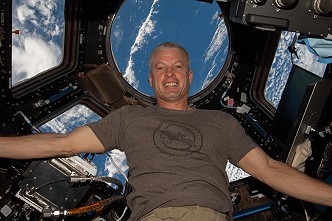 |
 |
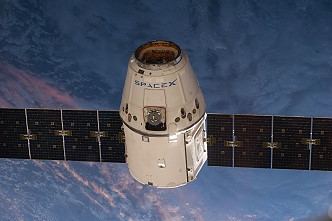 |
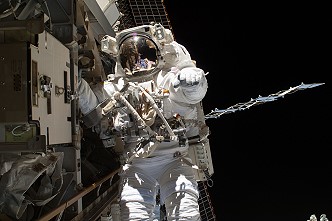 |
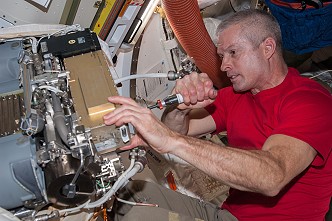 |
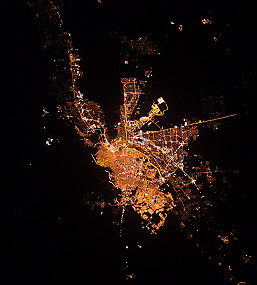 |
Earth observation photos |
|
more EVA photos |
|
more onboard photos |
|
| © |  |
Last update on November 10, 2023.  |
 |